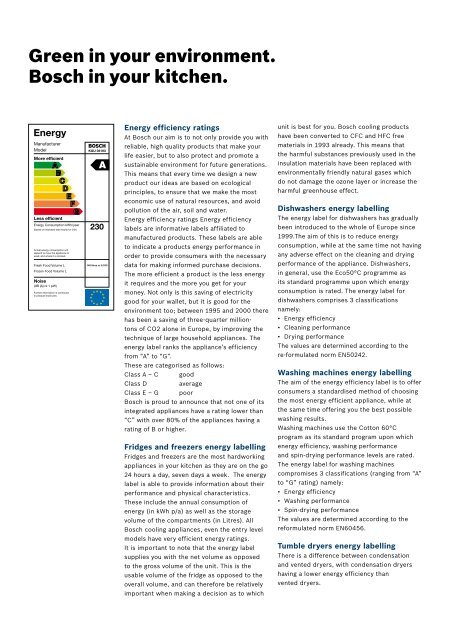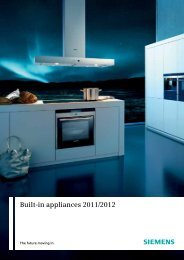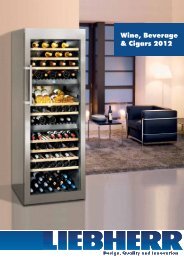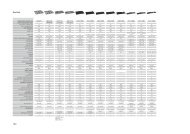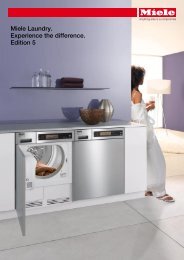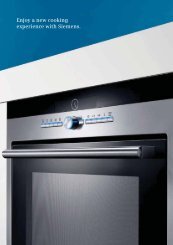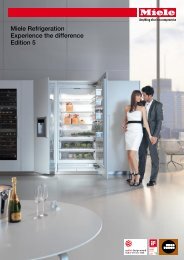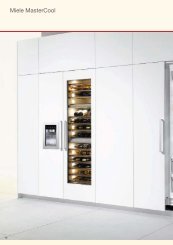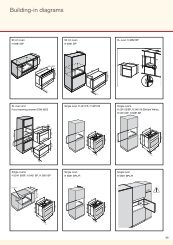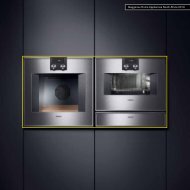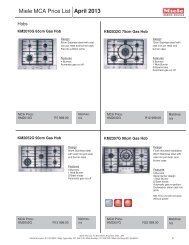Built-in Appliances - Euro Appliances
Built-in Appliances - Euro Appliances
Built-in Appliances - Euro Appliances
You also want an ePaper? Increase the reach of your titles
YUMPU automatically turns print PDFs into web optimized ePapers that Google loves.
Green <strong>in</strong> your environment.<br />
Bosch <strong>in</strong> your kitchen.<br />
Energy<br />
Manufacturer<br />
Model<br />
More efficient<br />
KGU 36193<br />
A<br />
Energy efficiency rat<strong>in</strong>gs<br />
At Bosch our aim is to not only provide you with<br />
reliable, high quality products that make your<br />
life easier, but to also protect and promote a<br />
susta<strong>in</strong>able environment for future generations.<br />
This means that every time we design a new<br />
product our ideas are based on ecological<br />
pr<strong>in</strong>ciples, to ensure that we make the most<br />
unit is best for you. Bosch cool<strong>in</strong>g products<br />
have been converted to CFC and HFC free<br />
materials <strong>in</strong> 1993 already. This means that<br />
the harmful substances previously used <strong>in</strong> the<br />
<strong>in</strong>sulation materials have been replaced with<br />
environmentally friendly natural gases which<br />
do not damage the ozone layer or <strong>in</strong>crease the<br />
harmful greenhouse effect.<br />
Less efficient<br />
Energy Consumption kWh/year<br />
(based on standard test results for 24h)<br />
Actual energy consumption will<br />
depend on how the appliance is<br />
used, and where it is located.<br />
Fresh Food Volume L<br />
Frozen Food Volume L<br />
Noise<br />
(dB (A) re 1 pW)<br />
Further <strong>in</strong>formation is cont<strong>in</strong>ued<br />
<strong>in</strong> product brochures<br />
230<br />
145 litres or 5.1ft3<br />
economic use of natural resources, and avoid<br />
pollution of the air, soil and water.<br />
Energy efficiency rat<strong>in</strong>gs Energy efficiency<br />
labels are <strong>in</strong>formative labels affiliated to<br />
manufactured products. These labels are able<br />
to <strong>in</strong>dicate a products energy performance <strong>in</strong><br />
order to provide consumers with the necessary<br />
data for mak<strong>in</strong>g <strong>in</strong>formed purchase decisions.<br />
The more efficient a product is the less energy<br />
it requires and the more you get for your<br />
money. Not only is this sav<strong>in</strong>g of electricity<br />
good for your wallet, but it is good for the<br />
environment too; between 1995 and 2000 there<br />
has been a sav<strong>in</strong>g of three-quarter milliontons<br />
of CO2 alone <strong>in</strong> <strong>Euro</strong>pe, by improv<strong>in</strong>g the<br />
technique of large household appliances. The<br />
energy label ranks the appliance’s efficiency<br />
from “A” to “G”.<br />
Dishwashers energy labell<strong>in</strong>g<br />
The energy label for dishwashers has gradually<br />
been <strong>in</strong>troduced to the whole of <strong>Euro</strong>pe s<strong>in</strong>ce<br />
1999.The aim of this is to reduce energy<br />
consumption, while at the same time not hav<strong>in</strong>g<br />
any adverse effect on the clean<strong>in</strong>g and dry<strong>in</strong>g<br />
performance of the appliance. Dishwashers,<br />
<strong>in</strong> general, use the Eco50°C programme as<br />
its standard programme upon which energy<br />
consumption is rated. The energy label for<br />
dishwashers comprises 3 classifications<br />
namely:<br />
• Energy efficiency<br />
• Clean<strong>in</strong>g performance<br />
• Dry<strong>in</strong>g performance<br />
The values are determ<strong>in</strong>ed accord<strong>in</strong>g to the<br />
re-formulated norm EN50242.<br />
These are categorised as follows:<br />
Class A – C good<br />
Class D<br />
average<br />
Class E – G poor<br />
Bosch is proud to announce that not one of its<br />
<strong>in</strong>tegrated appliances have a rat<strong>in</strong>g lower than<br />
“C” with over 80% of the appliances hav<strong>in</strong>g a<br />
rat<strong>in</strong>g of B or higher.<br />
Wash<strong>in</strong>g mach<strong>in</strong>es energy labell<strong>in</strong>g<br />
The aim of the energy efficiency label is to offer<br />
consumers a standardised method of choos<strong>in</strong>g<br />
the most energy efficient appliance, while at<br />
the same time offer<strong>in</strong>g you the best possible<br />
wash<strong>in</strong>g results.<br />
Wash<strong>in</strong>g mach<strong>in</strong>es use the Cotton 60°C<br />
program as its standard program upon which<br />
Fridges and freezers energy labell<strong>in</strong>g<br />
Fridges and freezers are the most hardwork<strong>in</strong>g<br />
energy efficiency, wash<strong>in</strong>g performance<br />
and sp<strong>in</strong>-dry<strong>in</strong>g performance levels are rated.<br />
appliances <strong>in</strong> your kitchen as they are on the go<br />
The energy label for wash<strong>in</strong>g mach<strong>in</strong>es<br />
24 hours a day, seven days a week. The energy<br />
compromises 3 classifications (rang<strong>in</strong>g from “A”<br />
label is able to provide <strong>in</strong>formation about their<br />
to “G” rat<strong>in</strong>g) namely:<br />
performance and physical characteristics.<br />
• Energy efficiency<br />
These <strong>in</strong>clude the annual consumption of<br />
• Wash<strong>in</strong>g performance<br />
energy (<strong>in</strong> kWh p/a) as well as the storage<br />
• Sp<strong>in</strong>-dry<strong>in</strong>g performance<br />
volume of the compartments (<strong>in</strong> Litres). All<br />
The values are determ<strong>in</strong>ed accord<strong>in</strong>g to the<br />
Bosch cool<strong>in</strong>g appliances, even the entry level<br />
reformulated norm EN60456.<br />
models have very efficient energy rat<strong>in</strong>gs.<br />
It is important to note that the energy label<br />
supplies you with the net volume as opposed<br />
to the gross volume of the unit. This is the<br />
usable volume of the fridge as opposed to the<br />
overall volume, and can therefore be relatively<br />
Tumble dryers energy labell<strong>in</strong>g<br />
There is a difference between condensation<br />
and vented dryers, with condensation dryers<br />
hav<strong>in</strong>g a lower energy efficiency than<br />
vented dryers.<br />
important when mak<strong>in</strong>g a decision as to which


